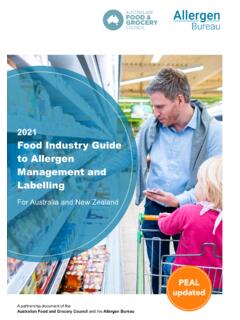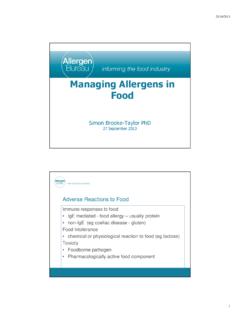Transcription of Version 3 - Allergen Bureau | Informing Industry
1 Informing the food April 2021 The food Industry Guide to the voluntary incidental trace Allergen labelling ( vital ) PROGRAM DisclaimerMaterial included in this publication is made available on the understanding that the AllergenBureau is not providing professional advice, that the vital Program is intended as a riskmanagement tool which may assist in a total approach to Allergen risk management, and that usingthe vital Program does not guarantee that a consumer will not suffer an allergic response. If youintend to use information provided in this publication, you must exercise your own skill, care andjudgement, evaluate the accuracy, completeness and relevance of any information orrecommendation for your purposes, and obtain your own professional advice.
2 Allergen Bureauprovides no warranty and does not guarantee the accuracy or completeness of the materialcontained in this publication, or in any recommendation obtained from it, including regardingcompliance with food labelling laws and regulations or the management of the risk of productliability and personal injury. The Allergen Bureau disclaims all liability to any person in respect of anyloss or liability suffered in connection with the reliance, whether wholly or partly, on anyinformation contained in this The Allergen Bureau Limited April 1. INTRODUCTION 4 vital Science 4 The Regulatory Framework & the vital Program 4 The vital Program 4 Use of The vital
3 Program 52. THE vital PROCEDURE 6 Scope 6 Pre-requisites 6 Determination of relevant allergens
4 6 Identification of intentionally added allergens 6 Identification of unintentional (cross contact) allergens from materials or ingredients 6 Identification of unintentional (cross contact) allergens due to processing 7 Particulate cross contact allergens 8 Readily dispersible cross contact allergens from materials or ingredients 8 Readily dispersible cross contact allergens due to processing 8 Calculation of total cross contact Allergen in finished product 9 Ingredients intended for further processing ( bulk product) 10 Determination of Reference Amounts for Packaged Products 10 Determination of Reference Doses for Packaged Products 10 Establish Action Levels for each identified cross contact Allergen in a Packaged Products 11 Validation of vital Assessment 11 Precautionary Allergen labelling 12 Recording of Assumptions 12 Ongoing Monitoring 123.
5 SUPPORTING INFORMATION 13 vital Online (including the interactive vital Action Level Grid) 13 Allergen Risk Review website 13 vital Best Practice labelling Guide 13 The vital Standard 13 vital Training 13 Allergen Risk Review Anomaly for Dark Chocolate
6 13 The vital Program and Allergen Analysis 14 Decision Tree for Cross Contact Allergens 154. GLOSSARY 163 Allergen Bureau food Industry Guide to the vital Program Version vital ScienceThe independent group of experts known as the vital Scientific Expert Panel (VSEP) reviewed the data from clinical (low-dose oral) food challenges from both published and unpublished studies. The papers were sourced from Australia, the United States and the European Union and over 3400 clinical data points were collated. The data included in the review was required to meet defined quality criteria to ensure that resulting Allergen thresholds were statistically sound.
7 The data set was analysed by applying a new Stacked Model Averaging program1 (Wheeler et al, 2019) for each allergenic food . The Stacked Model Averaging program produces a single curve for each Allergen from which Eliciting Doses (ED) may be derived. The VSEP identified the ED01 (which is the dose of the total Allergen protein that is predicted to produce objective symptoms in 1% of the allergic population) which were adopted as the Reference Doses for vital Further information about vital Science is available at the vital Online The Regulatory Framework & the vital ProgramThe vital Program has been developed against the Australian and New Zealand regulatory background and is also applicable in many international jurisdictions.
8 It is the responsibility of the user to determine the cross contact allergens that may impact their product and to ensure the appropriateness of using the vital Program and any labelling outcomes in their market. The vital ProgramThe objective of the vital Program is to ensure manufactured food is safe to consume for the vast majority of food allergic consumers by providing consistent food labels that declare the presence of allergens, due to documented, unavoidable and sporadic cross contact thus enabling allergic consumers and their carers to avoid purchasing foods that may present a personal risk. The vital Action Level Grid contains concentrations of cross contact Allergen proteins, called Action Levels, which determine when it is appropriate to use a precautionary Allergen labelling statement.
9 The Action Level concentrations are determined using the Reference Dose information (set by the vital Scientific Expert Panel) in conjunction with the associated Reference Amount. The vital Action Level Grid should be used in conjunction with this first Version of the vital Program was released in June 2007 in Australia and New of this document was released in 2012 post a review of the science underpinning the vital Program by an independent, newly formed expert panel known as the vital Scientific Expert Panel (VSEP). Version has been released to coincide with another major review of the underpinning science in mid-2019 completed by the VSEP. 1 Wheeler MW, Westerhout J, Baumert JL, Remington BC.
10 Bayesian Stacked Parametric Survival with Frailty Components and Interval Censored Failure Times. August 2019. food regulations in many countries require the mandatory declaration of certain allergens in food . As well as named allergens present in a food due to direct, intentional addition, allergens may also be present, even under conditions of Good Manufacturing Practice (GMP), due to cross contact with other materials. This could occur at any point along the food chain from primary production, raw materials and ingredients and through the manufacturing process. The voluntary incidental trace Allergen labelling ( vital ) Program has been developed to provide a risk-based methodology for food manufacturers to use in assessing the impact of Allergen cross contact and to provide appropriate precautionary Allergen labelling (PAL).




